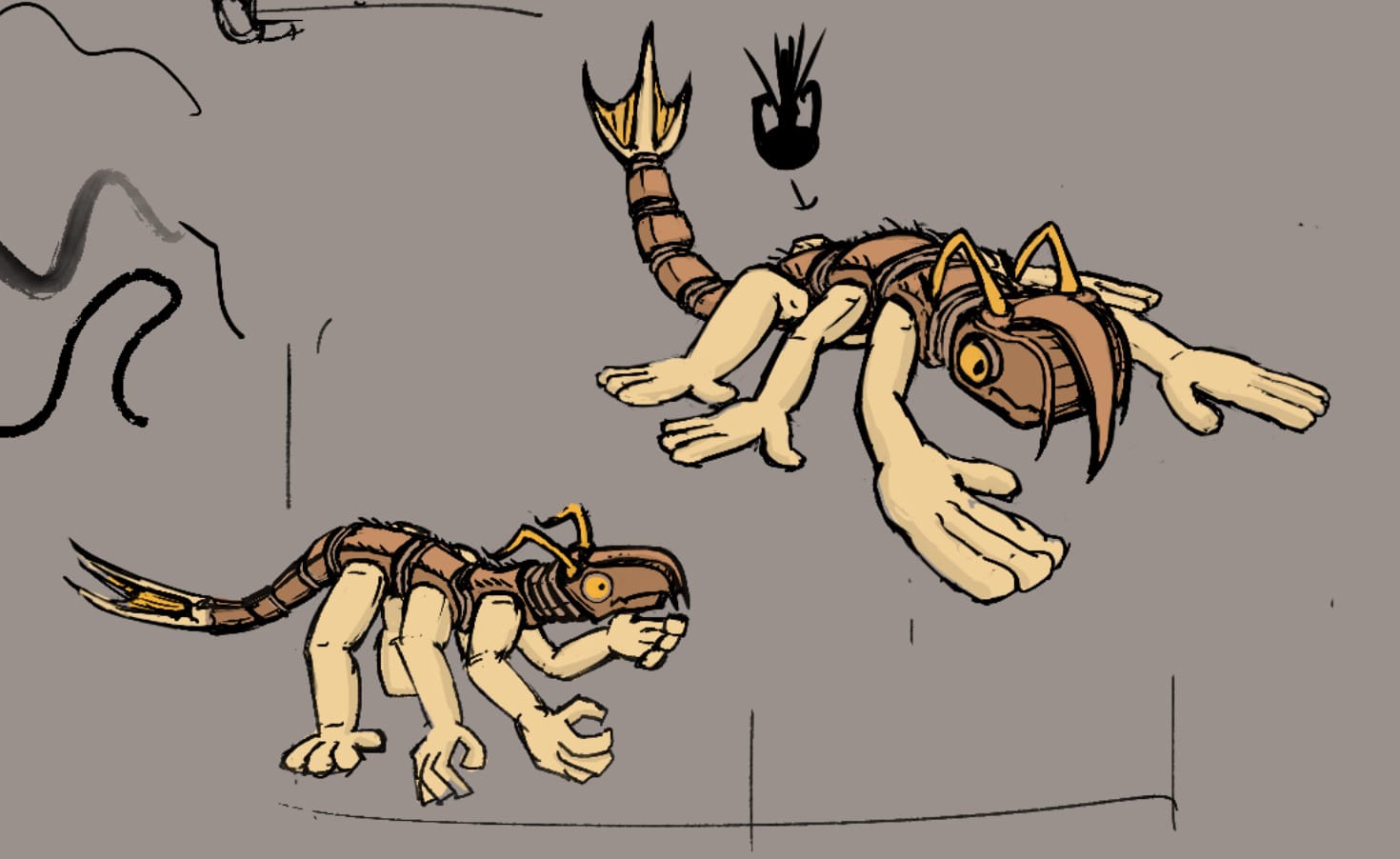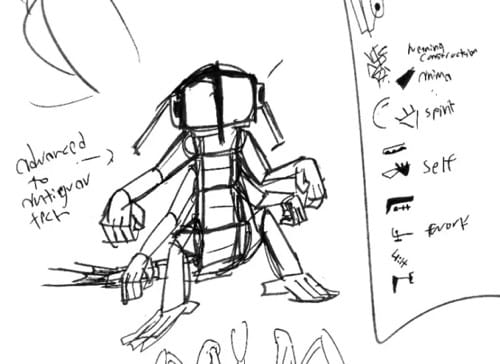The Aveterriat in Epoch 0

The Aveterriat originated from hexapodal piscoids from the planet Sidilico. A high gravity desert world which used to be an oceanic world. That was, until their homeworld's sun started to become a subgiant star and their world started to get dried. Multiple mass extinction events later, the life on Sidilico became adapted to the salty flats and basins instead of the oceans. The world's almost smog-like cloud conditions in many regions also create a world that is visually daunting, the sun clears the smog mid-day, but the cloudiness usually will re-assert itself by the evening.
The Aveterriat in particular have retained a range of traits from the tail fin to the peculiar eyes they have. Both features, adapted for hollow caverns and the coastlines of salty beach. Their primary 'side eyes' are large and are able to absorb more light in wavelengths that help see through the smog. The secondary frontal eyes meanwhile are more focused and granular, useful for precise short sight. They basically have 2 kinds of specialized eye instead of a single general kind of eye. This is why frontal views appear to have forward facing eyes while side views appear to have larger eyes. Such eye system originally developed from aquatic ancestors, but have managed to shift in purpose to fit the drier, saltier world their kind gained intelligence in.
A full grown Aveterriat is not big, around a (0.7-1 meter in length).
Physiology
Their ancestor's limbs also were fins. The body of an Aveterriat is held together by a composite of skeletons, with hydrostatic cartilage between the "leathery" segments and an endoskeleton in their limbs, limbs that have dense muscles due to the gravitational forces of their world leading to wider, flatter limbs. The neck of the Aveterriat has the most hydrostatic segments while there are two segments each between each section of their segmented body of case-like segments. The Aveterriat have redundant, smaller hearts in each section for circulation and respiration to deal with the stresses of a higher gravity world. Their "nose" analogs are located on the sides of their segments, with similarly redundant lung analogs. The antennae help with sensing wind patterns, useful when dwelling in a hazy atmospheric media.
The tail fin is mildly atavistic, but it has uses due to its reflectivity in a hazy environment for coordinating (in nature) and mate attraction. The brain is cased in the front like with us, with a distinct sensory melon and "prod" on their front that isn't actually a nose but a density sensory system that helps scoop food out from the ground as they are from a genus that preys on various burrowing species. The earth analog would be something like the crayfish that burrow on the beach. Aestivating organisms are common on their world. Their digestive system consists of a crop, stomach and a spiral valve intestine, with purposes analogous to the earthly counterparts.
The Aveterriat retain quite a bit of fluid in their body due to the relative scarcity of fluids on their planet through a solution that makes their internal fluids more gel-like (think aloe vera). There are dedicated organ systems for salt filtration and holding water beneath the thick, leathery segments of their body. Their fore and mid arms have prehensile hands while their legs are somewhat prehensile but are more foot-like. Aveterriat reproduction favors multiple male mates per female Aveterriat, with their more collective cultures being in part from how mothers have a high death rate in child birth due to their spawn ripping themselves out of the body (the hydrostatic segments mainly) at birth. The risk increases with the more spawn they incubate. There isn't any real sexual dimorphism except the male aveterriat having a more pronounced tailfin and the female aveterriat's body often being slightly wider. The facial prod is sometimes wider, other times more needle-like. Their arms have an endoskeleton, but their body segments have loose ribs. Their tail segments can reform after a long time, but their limbs cannot.
Habitation / Phonetics
The primitive Aveterriat often inhabited caves or salty shorelines, with some cultures benefiting from the flash rainstorms in more polar regions or the various rift regions rich in phosphorus and hot springs. The sun in their world is a subgiant star, oppressively gazing down upon them. The Aveterriat have heliophobia and quite a bit of dread of the sun as the day heat is oppressive even for life used to the dying world they occupy. The night and twilight are when they prefer being out and about for these reasons, even if they aren't actually threatened by their sun directly (except when a flare event occurs). It simply is the association of blaring heat from a god that hates them and the open pale skies full of death that often ensue.
More advanced societal structures are not covered in this article, but the basic unit from pre-technological times was fairly communal in nature with large populations cloistered about in built out caverns. Their kind never developed eusociality like comparable sapients (i.e the Stevik) in part due to their reproduction system being unsuited for it and how often the mother dies in child birth. Their colonies usually can mass up to tens of thousands of Aveterriat and often consist of intricate mazes of underground architecture with such numbers even before having sophisticated industries. In epoch 0, the Aveterriat already had elaborate and bespoke networks of societies. Surface societies also existed, but the widespread heliophobia usually led to them retreating underground whenever the sun of out to the point their settlements have bunker infrastructure so elaborate you would think they had nuclear weapons already. (They didn't until about epoch 4109)
Their communication and language is based around rattles, gutturals accented by hydrostatic throats, chirps and whistles. Their phonetics have consideration variation across the various cultures of aveterriat, where other variations in their coloration can be seen with wild amounts of color variation when it comes to their reflective tailfins or eyes despite the more rocky/salty/desert coloration their leathery segmented body, hydrostatic segments and softer limbs have. The Aveterriat tail fin's reflectivity is sometimes intentionally obscured by an Aveterriat by drenching it in salty mud, other times a sack is fastened around it.

The design had modifications, such as more fore/hind limb differentiation but I find myself wondering if this goes too against the Curl-Up inspirations that drove some of their design. Despite the curl-up inspirations, I have yet to draw them curling up.
I intend to write more articles like this in the coming days, if not weeks/months. So if you liked reading through the design logic and speculative evolution that went into the Aveterriat, subscribe to this newsletter for more as there is still quite a bit more to say about the Aveterriat and quite a few other species ive worked on and have backlogs of going all the way back to the year 2015.

